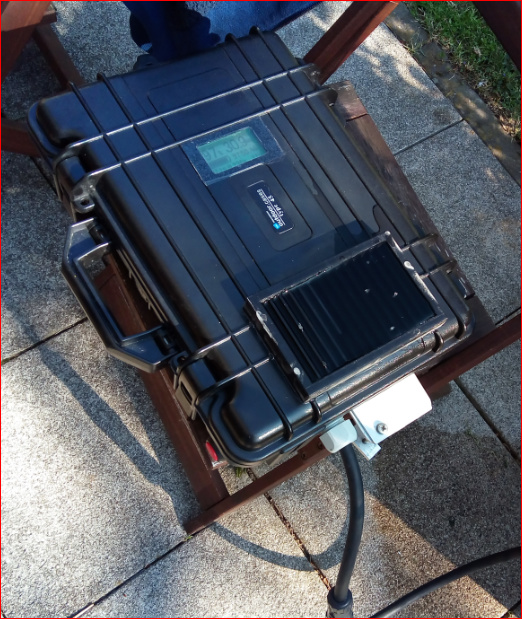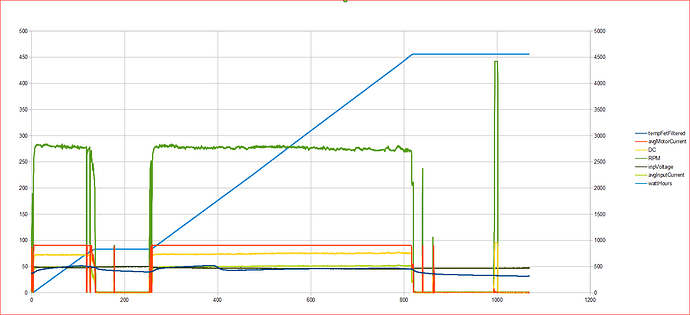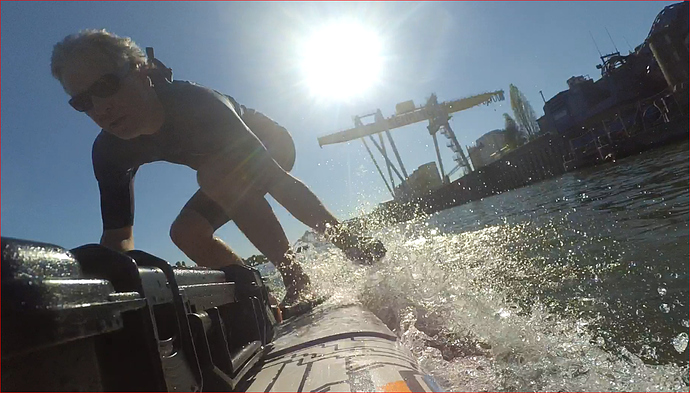Awesome! How long do you think it could sustain this power for with a heatsink that size?
Ran it again today at 110A, 55V. Video below. The temp rise is about 1C/4sec. The hottest thing is definitely the gate drive power supply. Fets are around 10C hotter than the board report. I would be comfortable setting the temp cutout in the 130-140C range. The fet packages would be 140-150C, and the die shouldn’t be much hotter than that.
The testing is definitely limited by the motors. I need new motors to get here 
I would not recommend to raise the temperature limit. I tried this once with a VESC Enertion FOCBOX and it died within hours. I think the FR4 is degrading at such temperature and also my handmade GFK sheet could suffer. I will start my tests around 85A motor current limit and see how it goes.
Testing at this power class seems to be problematic. Cooling is the clue as always. What motors do you use? Is it 80100? Can you put them under water?
Your thermal camery is a good tool, i see the logic board is heated and also the cables get hot.
I will stay with my fan inside the housing to cool the cables and capacitors.
some more fotos:
Modified lid with cooler PR158 enclosed by a 3DP frame.
Casted with epoxy of different styles. Spilled some water to test integrity.
Here is the engineering test, 5kW, 60V 100A input, 150A motor phase current.
This video shows the “battery side” ripple that a user would care about. It’s a little over 2Vpp at 150A motor current. Not sure if this is a deal breaker.
I think my golf cart batteries are still not quite powerful enough to supply the burst. They’re dropping from 60V to 50V, so the power is 5kW instead of 6kW. I’d say it is approximately comparable in size and weight to the Freefly ARC200, except it can do 14s. Obv the mechanical design still leaves something to be desired- if only I had corporate funding and a machine shop…
Finally it’s time to make some more copies for testing in a real world application. 

Here comes some practice test:
Settings: FOC, 90A Max motor, PPM controls current.
At around 400 seconds i realized the cooler was still dry, so i felt it got a little warm and put some water into it.
Afterwards, the temperature is practically not rising, staying below 50°C! This is what i wanted! 8 Minutes riding at full throttle with 2300W. It really makes a big difference in the feeling and sensibility compared to the 1800W i got before with my tuned VESC 4.12, because the board is clearly gliding. Now it makes turns rather easily and is sensible for my wheight shifting.
For some reason my TF02 which i use as a battery gauge frozed the values and including battery voltage, so i stopped rather early. At home, after disconnection and reconnection it worked as if nothing ever happened.
Tomorrow i will set the motor current to 100A and try again.
The spike at 1000s is freerunning in air!
Thank you a lot for this controller, it is small, light, has much more power than the best VESC 4 i tuned and solves the problem with a lot of headroom and potential for further optimization. I was very surprised how little there was missing to reach the goal!
Thanks also to Flo, who made the Software for the ESP which transfers data from the VESC via a WLAN into my smartphone, and various tools into this stunt graph. Thank you a lot, i learned a lot of this forum.
Congrats to Nick on a first successful water test of his ESC! I’m excited to see further tests PG!
At today tests the ESP was not running, i do not recall why. Instead my BMS worked today so we had a rather constant reading on the display of 2.9kW. Speed was slightly higher than yesterday. Emptied 90% of battery capacity and had lots of fun with my son.
Also i used a geo tracker app today, but i am little disappointed of the quality reached. Stated a max speed of 23km/h which i do not believe. I think 18 to 20km/h constant speed is realistic data.
Made some bollard thrust test and altough the VESC always stopped when passing 35kg it was kind of impressive.
In the measurement from yesterday i found some fault code 4 which stands for Abs over current for 0.6s and also today i had some sudden stops. It was dependent on the amount of acceleration.
@nickw1881 is it possible to set over 160A abs current with the current firmware and hardware?
You need a new binary. I have one here: BLDC_4_ChibiOS_DT600.bin - Google Drive
ABS max current can now be set up to 190 A. Please keep in mind that the .5 mOhm shunts only sense up to 165A, so if you want to go higher than that you’ll need to turn on high current sampling mode.
All the vocabulary you guys are using is very impressive but also so Chinese to me…
Will that looking-great ESC be idiot-proof for people like me to be able to use it, and thus extend your base of potential buyers ?
+1
(plus one; at least 20 characters, that is the minimum)
Well, somehow the max current cannot be changed. I think it has to be compiled with NO HW LIMITS.
Anyhow, i tested a prop with less pitch, with 100A phase current limit and there were no stops anymore which is a great gain.
My telemetry does not work at the moment, but as the maximum power was 3.4kW in the beginning and went down to 2.9kW in the end i assume it was running near 95% dutycycle. This means the phase current dropped from 100A to 75A by changing the pitch from 8 to 7". The geotracker reports 21km/h maximum velocity and this is very small gain.
@nickw1881
I read the whole topic, and I’m really interested in such a Esc. Do you have some plans, or is the esc still available? I’m at he beginning of building an efoil.
Max
I’m getting 10 of them made right now. If nothing goes wrong, no trade war, nothing is impounded by ICE, no workmanship defects, the assembler doesn’t substitute non-brand crap capacitors, I should have them in hand in about 3 weeks.
They are “public beta” status. I will be selling them with no heat sink for $240 + shipping. That’s less than my cost, but I think a fair price for an untested product. I’ll need feedback on what doesn’t work or what broke. For what it’s worth, they work just fine on the dyno, just not sure about the weird stuff that only happens in the real environment.
I’m working on a heat sink, in case people want something partially enclosed like the ARC200. That will cost extra.
Still not sure the final sale price for this design, probably $350, unless the magical promotional ad campaign fairy comes and makes a really cool promotional ad campaign for kickstarter and I can make them in batches of 1000.
Today i was lucky my metr app worked as expected:
This was with 7" prop. As you can see, the dutycycle is permanent at maximum of 95%. This week i am going to receive 300µohm shunts to avoid shutdowns by overcurrent. Than i will try with 8" prop again with higher current settings, so i hope to build up even more speed and power.
It am sorry to ask you that but i need to understand : how do you 90a on motor with only 60a at the battery on 95% duty ?
@Alexandre According to Benjamin Vedder, the motor current reported by the VESC is the current used to create the magnetic field. It’s something that comes out of the math guts of the FOC algorithm, and it seems to be pretty close to the sinusoid peak for each phase.
I think about it like this: in a DC load, the voltage all drops across the load as work. Each electron delivers ALL of its potential energy to the load. High pressure on the input side, low pressure on the output side, and the current flow is directly proportional to the load.
In a BLDC motor, the motor creates most of it’s own voltage by spinning, so there isn’t a huge pressure drop from electrons slamming into a wall and losing all their energy. Each electron can only transfer energy equal to the difference between the input voltage (pwm duty x battery) and the motor rpm (motor rpm x kV). Instead, larger numbers of electrons will flow, each doing relatively little work.
So maybe think about the controller as a small accumulator tank: A few high energy electrons slam into the tank from the battery, and large numbers of low energy electrons flow out into the motor. Even when the duty cycle is 100%. That’s about as good as I can understand the physics.
For power analysis, the “Motor current” measurement is useless, unless you know the efficiency of the controller and the power factor of the motor, which is probably dependent on RPM and torque. But I think it does tell you something about how much relative torque you are putting into the motor, and it does tell you if you are exceeding the motor current specification.
It is an interesting plot, as you can see we got overvoltage failure at 18:15:07 , when i triggered the main switch, so the battery is disconnnected in ground path. At 18:15:53 s we have overcurrent reached, the typical announcement of the vesc, when you go too steep.
Thank you , i am new with the foc mode which i will run this year… Didn’t think about this amp"pics" of the motor…
As i was thinking to get the power used by the motor close to the power of the battery in order to stay around a nice torque/trust area ( bigger propeller data will be interesting  )
)
Missing the rpm value on the data for calculating the torque value …
I am trying to get my way around the numbers in order to estimated the best combo pitch/diameter/rpm for my needs


